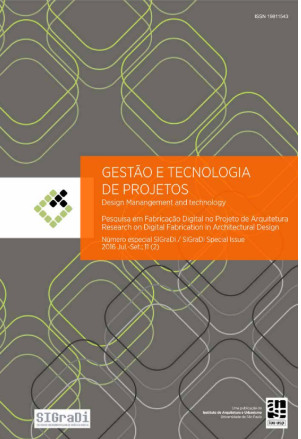Formwork fabrication freedom for a concrete canoe
DOI:
https://doi.org/10.11606/gtp.v14i1.148264Keywords:
Concrete, 3D Printing, Formwork, Canoe, Design, Topology OptimizationAbstract
The pursuit for complex geometries in contemporary architecture is driving innovation towards an unconstrained fabrication freedom for building components. Concrete is a building material with excellent structural and architectural qualities, which has the theoretical capacity of being cast into any shape. However, in practice, concrete is generally limited by the formwork manufacturing industry to simple, planar shapes. To overcome this fabrication limitation, this research investigates the use of large-scale 3D-printed plastic formworks for concrete components. This novel construction method takes advantage of the load-bearing capacity of concrete and relies on the fabrication-freedom inherited from the 3D printed formwork, thus making complex topologies and precise details possible for concrete structures. To demonstrate the potential applications of this method, skelETHon —a functional four-meter-long concrete canoe— was designed, built and raced in a regatta on the Rhine river. The research focused on the optimization of the 3D printing process for large-scale plastic formworks and on improving the stability of the thin formwork shells during casting.
Downloads
References
Aghaei-Meibodi, M., Bernhard, M., Jipa, A., & Dillenburger, B. (2017, 6-8 April 2017). The Smart Takes from the Strong. Paper presented at the Fabricate 2017: Rethinking Design and Construction, University of Stuttgart, Germany.
Crow, J. M. (2008). The concrete conundrum. Chemistry World, 5(3), 62-66.
Fontana, M., Flatt, R., Marchon, D., & Lex, R. (2014). Switzerland Patent No. EP 2 902 183 A1. E. P. Office.
Hack, N., Lauer, W., Langenberg, S., Gramazio, F., & Kohler, M. (2013). Overcoming Repetition: Robotic fabrication processes at a large scale. International Journal of Architectural Computing, 11(3), 285-299.
Hack, N., & Lauer, W. V. (2014). Mesh‐Mould: Robotically Fabricated Spatial Meshes as Reinforced Concrete Formwork. Architectural Design, 84(3), 44-53.
Jipa, A., Bernhard, M., Dillenburger, B., & Aghaei-Meibodi, M. (2016). 3D-Printed Stay-in-Place Formwork for Topologically Optimized Concrete Slabs. Paper presented at the 2016 TxA Emerging Design + Technology, San Antonio, Texas, USA.
Nervi, P. L. (1956). Structures FW Dodge Corp.
Oesterle, S., Vansteenkiste, A., & Mirjan, A. (2012). Zero waste free-form formwork. Paper presented at the Proceedings of the Second International Conference on Flexible Formwork, ICFF. CICM and University of Bath, Dept. of Architecture and Civil Engineering.
Peters, B. (2014, 23-25 October, 2014). Additive Formwork: 3D Printed Flexible Formwork. Paper presented at the ACADIA 14: Design Agency, Los Angeles.
Popescu, M., Reiter, L., Liew, A., Van Mele, T., Flatt, R. J., & Block, P. (2018). Building in Concrete with an Ultra-lightweight Knitted Stay-in-place Formwork: Prototype of a Concrete Shell Bridge. Structures, 14, 322-332. doi:https://doi.org/10.1016/j.istruc.2018.03.001
Post, B., Lloyd, P. D., Lindahl, J., Lind, R. F., Love, L. J., & Kunc, V. (2016). The Economics of Big Area Addtiive Manufacturing: Oak Ridge National Laboratory (ORNL), Oak Ridge, TN (United States). Manufacturing Demonstration Facility (MDF).
Robert, H. (2007). Think formwork–reduce cost. Structure magazine, 14.
Ruffray, N., Bernhard, M., Jipa, A., Aghaei-Meibodi, M., Taisne, N. M. d., Stutz, F., Wangler, T., Flatt, R. J., Dillenburger, B. (2017). Complex architectural elements from HPFRC and 3D printed sandstone. Paper presented at the RILEM Symposium on Ultra-High Performance Fibre-Reinforced Concrete, Montpellier, France.
Rust, R., Jenny, D., Gramazio, F., & Kohler, M. (2016). Spatial Wire Cutting: Cooperative robotic cutting of non-ruled surface geometries for bespoke building components. Paper presented at the Living Systems and Micro-Utopias: Towards Continuous Designing, Proceedings of the 21st International Conference on Computer-Aided Architectural Design Research in Asia (CAADRIA 2016) Melbourne
Shahab, A., Lloret, E., Fischer, P., Gramazio, F., Kohler, M., & Flatt, R. (2013). Smart dynamic casting or how to exploit the liquid to solid transition in cementitious materials. Paper presented at the Proceedings CD od the 1st international conference on rheology and processing of construction materials and of the 7th international conference on self-compacting concrete, Paris, France.
Søndergaard, A., & Dombernowsky, P. (2011). Unikabeton prototype. Paper presented at the Fabricate: Making Digital Architecture.
Veenendaal, D., West, M., & Block, P. (2011). History and overview of fabric formwork: using fabrics for concrete casting. Structural Concrete, 12(3), 164-177.
Downloads
Published
Issue
Section
License
Copyright Notice
Authors who publish in this journal agree to the following terms:
- Authors retain the copyright and grant the journal the right of first publication, with the article simultaneously licensed under the Creative Commons Attribution License BY NC ND, which allows the sharing of article with acknowledgment of authorship and initial publication in this journal.
- Authors are authorized to take additional contracts separately, for non-exclusive distribution of version of the article published in this journal (e.g. publish in institutional repository or as a book chapter), with acknowledgment of authorship and initial publication in this journal.
- Authors are allowed and encouraged to publish and distribute their research work online (e.g. in institutional repositories or on their personal page) at any point before or during the editorial process, as this can generate productive changes, as well as increase the impact and the citation of published article (See O Efeito do Acesso Livre).
Funding data
-
Schweizerischer Nationalfonds zur Förderung der Wissenschaftlichen Forschung
Grant numbers 51NF40-141853



